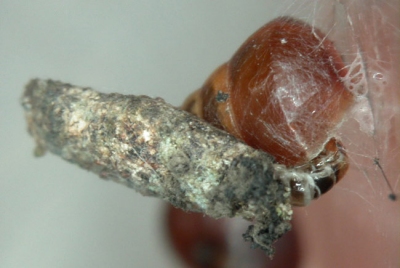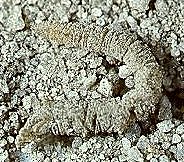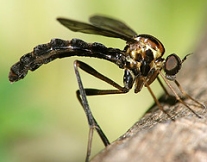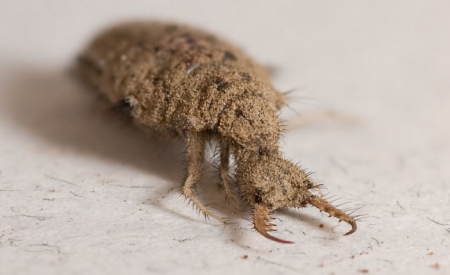| Lethal Larvae |
In older insects such as cockroaches, crickets, earwigs, silverfish and true bugs, offspring more or less
resemble stunted adults, a life cycle known as "incomplete metamorphosis." More advanced insects, on the
other hand, undergo "complete metamorphosis," drastically transforming from grub to beetle, maggot to fly
or caterpillar to moth.
Anthropomorphism tells us these stages parallel "child" and "adult" - that the larval stage is in some way
incomplete or merely a path to a goal. In most cases, however, the larval state is the more active, more
unusual and more complex, often constituting the vast majority of the animal's lifespan. The final stage can
often be thought of as little more than a dispersal mechanism, a reproduction machine that lives only long
enough to generate the next wave of larvae. Some will never even feed as "adults," using the larval stage
to stockpile energy for one brief frenzy of mating before their death.
A majority of insect larvae, such as maggots and caterpillars, are either scavengers or plant eaters. Others,
such as many wasps, are parasitic. In this article, we'll be running through some of the insect kingdom's
wriggliest predators, who compensate for a lack of high mobility with an impressive range of sneaky hunting
techniques.
resemble stunted adults, a life cycle known as "incomplete metamorphosis." More advanced insects, on the
other hand, undergo "complete metamorphosis," drastically transforming from grub to beetle, maggot to fly
or caterpillar to moth.
Anthropomorphism tells us these stages parallel "child" and "adult" - that the larval stage is in some way
incomplete or merely a path to a goal. In most cases, however, the larval state is the more active, more
unusual and more complex, often constituting the vast majority of the animal's lifespan. The final stage can
often be thought of as little more than a dispersal mechanism, a reproduction machine that lives only long
enough to generate the next wave of larvae. Some will never even feed as "adults," using the larval stage
to stockpile energy for one brief frenzy of mating before their death.
A majority of insect larvae, such as maggots and caterpillars, are either scavengers or plant eaters. Others,
such as many wasps, are parasitic. In this article, we'll be running through some of the insect kingdom's
wriggliest predators, who compensate for a lack of high mobility with an impressive range of sneaky hunting
techniques.
| -Snail Hunters- |

One of the few carnivorous caterpillars and the only known variety to trap its prey with silk, the Hyposmocoma
molluscivora ("mollusk eating") caterpillar is native to the few remaining forests of the Hawaiian islands, where
it was discovered in 2005 by biologist Daniel Rubinoff. Like a bagworm, this half-inch larva carries with it a
casing of silk, but employs both for protection and as a sort of hunting tool. When it encounters a tiny land
snail, it attacks like a sewing machine, binding the prey in place with a series of silken strands. Wedging the
edge of its bag under its victim's shell, it follows the snail inside and feeds at its liesure. Later, it may even
incorporate the empty shell into its own bag, offering further protection against caterpillar-eating predators.
molluscivora ("mollusk eating") caterpillar is native to the few remaining forests of the Hawaiian islands, where
it was discovered in 2005 by biologist Daniel Rubinoff. Like a bagworm, this half-inch larva carries with it a
casing of silk, but employs both for protection and as a sort of hunting tool. When it encounters a tiny land
snail, it attacks like a sewing machine, binding the prey in place with a series of silken strands. Wedging the
edge of its bag under its victim's shell, it follows the snail inside and feeds at its liesure. Later, it may even
incorporate the empty shell into its own bag, offering further protection against caterpillar-eating predators.
| -Corpse Collectors- |

The last Lepidoptera here, Perisceptis carnivora is a true bagworm directly related to the plant pests found
throughout the world, and like its cousins, constructs a protective casing out of the remains of its meals, but
instead of dried leaves, bark and pine needles, carnivora's portable house is as morbid as you may have
already guessed. Unlike other predatory caterpillars, it feeds on a wide variety of different prey, virtually
anything it can catch. Attaching one end of its back to a solid surface, it lies in wait and springs out like a
Jack-in-the-box to snare insects, spiders and any other arthropod that wanders too close. It has been
speculated that it may release an odor to help lure prey, but its collection of rotting limbs may entice many
curious scavengers on its own. Unlike other bagworms, both the male and female metamorphose into
complete, winged moths.
throughout the world, and like its cousins, constructs a protective casing out of the remains of its meals, but
instead of dried leaves, bark and pine needles, carnivora's portable house is as morbid as you may have
already guessed. Unlike other predatory caterpillars, it feeds on a wide variety of different prey, virtually
anything it can catch. Attaching one end of its back to a solid surface, it lies in wait and springs out like a
Jack-in-the-box to snare insects, spiders and any other arthropod that wanders too close. It has been
speculated that it may release an odor to help lure prey, but its collection of rotting limbs may entice many
curious scavengers on its own. Unlike other bagworms, both the male and female metamorphose into
complete, winged moths.
| -The Pitfalls of Ant Life- |

When an ant or other tiny insect slips on the pit's edges, the lurking monster uses its shovel-like head to
fling scoopfuls of sand out of the pit creating an almost inescapable landslide. When its victim stumbles into
the waiting jaws, it is instantly dragged underground, injected with a digestive enzyme and sucked dry of soft
tissues. They are so adapted to this lifestyle of digging, lurking and dragging that they are only capable of
moving backwards, and construct their pit by repeatedly flinging sand as they crawl in an inward spiral.
Various species may spend up to three years in the pit-building state, and only a few months as
dragonfly-like adults.
fling scoopfuls of sand out of the pit creating an almost inescapable landslide. When its victim stumbles into
the waiting jaws, it is instantly dragged underground, injected with a digestive enzyme and sucked dry of soft
tissues. They are so adapted to this lifestyle of digging, lurking and dragging that they are only capable of
moving backwards, and construct their pit by repeatedly flinging sand as they crawl in an inward spiral.
Various species may spend up to three years in the pit-building state, and only a few months as
dragonfly-like adults.


Though certainly more famous, antlions aren't the only insect larvae to stumble on this hunting technique.
Identical pit traps are employed by fly maggots of the family Vermileonidae, literally meaning "worm-lions."
Identical pit traps are employed by fly maggots of the family Vermileonidae, literally meaning "worm-lions."
| -Sheep's Clothing- |

Lacewings belong to the order Neuroptera, alongside other fascinating insects discussed here and in
some of my other articles. Antlions, mantidflies, and even the spongilla flies are all extreme variations of
the lacewing clan, and the "traditional" Lacewing larva is no less bizarre. The majority are predators of
aphids, scale insects and other pesky "plant lice", which are often protected by colonies of ants who "milk"
the sap-sucking insects for their sugary, nutritious excrement. To sneak past these shepherds, many
lacewing larvae employ velcro-like bristles to coat themselves in the corpses of stray aphids or even the
"wool" that certain plant parasites secret for (apparently less than adequate) protection. Others may simply
cover their bodies in bits of bark, fungus, leaves or various other dead insects, earning them the nickname
"litterbug" in some regions.
some of my other articles. Antlions, mantidflies, and even the spongilla flies are all extreme variations of
the lacewing clan, and the "traditional" Lacewing larva is no less bizarre. The majority are predators of
aphids, scale insects and other pesky "plant lice", which are often protected by colonies of ants who "milk"
the sap-sucking insects for their sugary, nutritious excrement. To sneak past these shepherds, many
lacewing larvae employ velcro-like bristles to coat themselves in the corpses of stray aphids or even the
"wool" that certain plant parasites secret for (apparently less than adequate) protection. Others may simply
cover their bodies in bits of bark, fungus, leaves or various other dead insects, earning them the nickname
"litterbug" in some regions.

| -Killer Foliage- |

Moths of the family Geometridae derive their name, "Earth Measure," from their famous "inchworm"
caterpillars, and actually include some of the first carnivorous varieties ever observed. Like most
inchworms, they rely on their resemblance to a twig or plant shoot to camouflage themselves almost
perfectly from other animals, but have modified this tactic from purely defensive to a form of predatory
ambush, much like the preying mantids and other stealthy carnivores. These, too, are native to the
Hawaiian islands.
caterpillars, and actually include some of the first carnivorous varieties ever observed. Like most
inchworms, they rely on their resemblance to a twig or plant shoot to camouflage themselves almost
perfectly from other animals, but have modified this tactic from purely defensive to a form of predatory
ambush, much like the preying mantids and other stealthy carnivores. These, too, are native to the
Hawaiian islands.
| Photo by Susan M Mccann |

Sometimes known as doodlebugs, sand dragons, or even ant hell in Japan, "antlions" are fierce predators
famous for the conical pits that certain species excavate in sand or fine soil, burying themselves at the bottom
as they wait for prey.
famous for the conical pits that certain species excavate in sand or fine soil, burying themselves at the bottom
as they wait for prey.